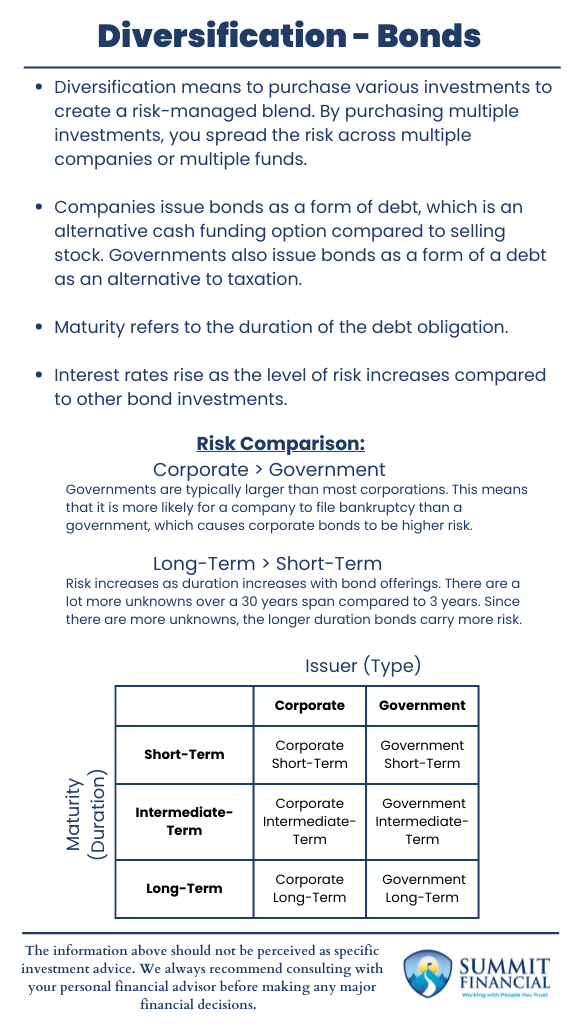As the saying goes, do not place all your eggs in one basket. This is perhaps one of the most important lessons when discussing investment management and retirement planning. Before we dive into the various diversification options, if you need a refresher on diversification in general, please reference our post from last month. (This post will solely cover diversifying bond or fixed income positions. Last month we discussed stocks and next month will be regarding miscellaneous investments.)
Importance of Bond Diversification
We do feel the need to address the concern of overdiversification. Having your investments spread too thin may hinder the potential for more substantial growth. We feel that it is important to focus on the companies and areas that have the ability to outperform and decrease exposure to those that may be expected to underperform. As Warren Buffet once said, “Wide diversification is only required when investors do not understand what they are doing.”

Issuer Diversification: Corporate vs. Government Bond
The issuer of a bond is the source of the bond itself. The two main issuers we will discuss today are corporations and governments. Companies issue bonds as a form of debt, which is an alternative cash funding option compared to selling stock. Governments also issue bonds as a form of debt as an alternative to taxation. The issuer is the source of the debt, and they typically make the debt payments to the bondholders or the investor.
Risk and Interest Rates in Bond Investments
The interest rate associated with a bond is primarily based off of the underlying risk associated with the issuer. If the underlying company goes bankrupt, you may only receive a portion of the bond value, if anything. The riskier the issuer, the higher the interest rate. Investors are paid more for buying the debt of riskier companies. Ultra-risky companies are often referred to as Junk Bonds. Those with higher credit ratings are considered Investment Grade. The difference between these two is mainly the fact that investment-grade companies are less likely to go bankrupt, so they issue debt with a lower interest rate.
Governments are typically more reliable, so treasury bonds typically carry a lower interest rate. However, the strength of the United States government is more dependable than that of any American company. Foreign countries, especially those that are smaller, often issue debt at higher interest rates compared to domestic options. Investors in these bonds could be subject to additional risks, such as political risk. Various changes, such as elections, legislation, and even war, could affect the debt-paying ability of the underlying government.
Maturity Diversification: Short-term, Intermediate-term, and Long-term Bonds
Next up we will discuss the various maturity options for bonds. Maturity essentially refers to the duration of the debt obligation. There are short-term bonds, intermediate-term bonds, and long-term bond options. Like we mentioned above, interest rates increase with a higher level of risk. Purchasing debt for 30 years is much more risky than purchasing debt for three years. There are a lot more unknowns and a lot more risk possibilities that can occur over 30 years than can occur in 3 years.
In summary, there are two primary ways that an investor can diversify their bond holdings. The first is a blend of corporate and government bonds, and the second includes a blend of varying maturities. The goal of this diversification is to potentially reduce risk within your bond holdings while also maintaining a sufficient level of yield.
Speak With a Trusted Advisor
If you have any questions about your investment portfolio, tax strategies, our 401(k) recommendation service, or other general questions, please give our office a call at (586) 226-2100. Please feel free to forward this commentary to a friend, family member, or co-worker. If you have had any changes to your income, job, family, health insurance, risk tolerance, or your overall financial situation, please give us a call so we can discuss it.
We hope you learned something today. If you have any feedback or suggestions, we would love to hear them.
Sincerely,
Zachary A. Bachner, CFP®
with contributions from Robert Wink, Kenneth Wink, and James Wink
Sources:
If you found this article helpful, consider reading:


